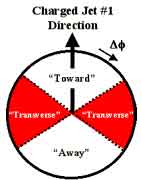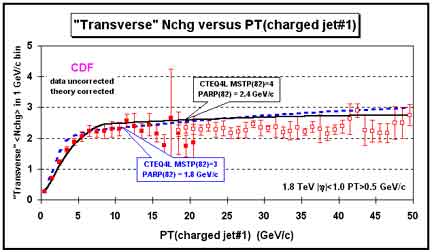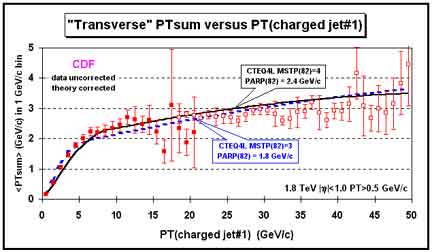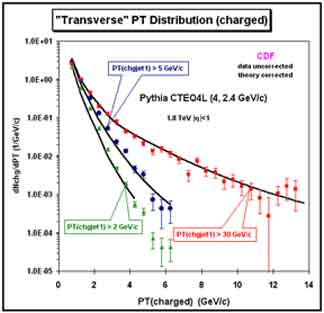 |
Tuning PYTHIA |
|||||||||||||||||||||
The increased activity in the "underlying event" of a hard scattering collision over that observed in "soft" collisions cannot be explained solely by initial-state radiation. Multiple parton interactions provide a natural way of explaining this increased activity. A hard scattering is more likely to occur when the "hard cores" of the beam hadrons overlap and this is also when the probability of a multiple parton interaction is greatest. For a soft grazing collision the probability of a multiple parton interaction is small. The "transverse" region is sensitive to the "underlying event" and we would like to tune the multiple parton interaction parameters of PYTHIA to fit the data. Some of the tunable parameters are shown below. The latest versions of PYTHIA (6.120 and higher) include additional parameters that allow one to adjust the energy dependence of multiple parton interactions. |
||||||||||||||||||||||
|
||||||||||||||||||||||
 |

|
|||||||||||||||||||||
| The above figure shows the data on the average number of "transverse" region charged particles compared with the QCD Monte-Carlo model predictions of PYTHIA 6.115, PYTHIA 6.125, and PYTHIA 6.115 with no multiple parton interactions, each with PT(hard) > 3 GeV/c. As shown below the PYTHIA default values sometimes change as the version changes. In particular, the effective minimum transverse momentum for multiple parton interactions, PARP(81), changed from 1.4 GeV/c in version 6.115 to 1.9 GeV/c in version 6.125. Increasing this cut-off decreases the multiple parton interaction cross section which reduces the amount of multiple parton scattering. | ||||||||||||||||||||||
|
||||||||||||||||||||||
 |

|
|||||||||||||||||||||
 |

|
|||||||||||||||||||||
| The above figures show data on the average number of charged particles in the "transverse" region compared with the QCD Monte-Carlo predictions of PYTHIA 6.115 with different structure functions and different multiple parton interaction parameters and with PT(hard) > 0 GeV/c. For PYTHIA the amount of multiple parton scattering depends on the parton distribution functions (i.e. the structure functions) and hence the number of particles produced in the "transverse" region (i.e. the "underlying event") changes if one changes the structure functions. HERWIG and ISAJET do not include multiple parton scattering and for them the number of particles in the "transverse" is essentially independent of the choice of structure functions. | ||||||||||||||||||||||
 |

|
|||||||||||||||||||||
 |

|
|||||||||||||||||||||
| The above figures show data on the average number of charged particles and the average scalar PTsum in the "transverse" region compared with "tuned" versions PYTHIA 6.115 using the CTEQ4L structure functions. One must first choose a structure function and then tune the multiple parton scattering parameters for that structure function. The PYTHIA curves are generated with taken PT(hard) > 0 GeV/c. In general the perturbative 2-to-2 parton scattering subprocesses diverge as PT(hard) goes to zero. PYTHIA regulates these divergences using the same cut-off parameters that are used to regulate the multiple parton scattering cross section (see the above Table). This allows for the possibility of using PYTHIA to simultaneously describe both "soft" and "hard" collisions. Most of the CDF Min-Bias events are "soft", with less than 3% of the events having PTJ1 > 5 GeV/c. There is no clear separation between "soft" and "hard" collisions, but roughly speaking PTJ1 < 2 GeV/c corresponds to "soft" Min-Bias collisions and demanding PTJ1 > 5 GeV/c assures a “hard” collision. From above we see that that the "tuned" versions of PYTHIA with PT(hard) > 0 GeV/c describes fairly well the transition between "soft" and "hard" collisions. | ||||||||||||||||||||||
 |

|
|||||||||||||||||||||
|
The above figure shows the data on the transverse momentum distribution of charged particles in the
"transverse" region compared with a "tuned" version of
PYTHIA 6.115 (CTEQ4L, MSTP(82) = 4, PARP(82) = 2.4 GeV/c).
The fit is not perfect, but it is better than the HERWIG prediction,
which does not include multiple parton interactions. Multiple parton
scattering produces more large PT particles in the "transverse" region, which is what is needed to fit the data.
The PT distribution in the "transverse" region, at low values of PTJ1, for the "tuned"
version of PYTHIA is also dominated by the "beam-beam remnant" contribution as is the
case for HERWIG.
However, for PYTHIA the "beam-beam remnant" component includes contributions from
multiple parton scattering, which
results in a less steep PT distribution.
One should not take these "tuned" versions of PYTHIA too seriously. It is encouraging that they describes fairly well the "transverse" region over the range 0 < PTJ1 < 50 GeV/c including the transition from "soft" to "hard" collisions. However, they are still not quite correct. For example, they do not reproduce very well the multiplicity distribution of "soft" collisions. More work needs to be done in tuning the Monte-Carlo models. In addition, more work needs to be done before one can say that the multiple parton interaction approach is indeed correct. (Return to the "Transverse" Region) |
||||||||||||||||||||||